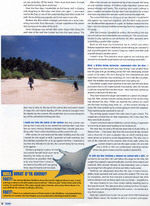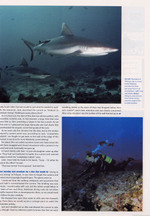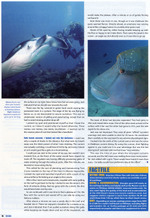Have you ever read a diving travel article and wondered what goes on behind the scenes?
I've just had an article published in DIVER magazine called, "Market Forces," about diving in the Algarve, Portugal. Click on the thumb nails to read it, and at the same time I'll explain how it came about.
 Like most assignments, it started with a phone call from the editor asking if I would be interested in the trip. Prior to this the PR agency who represent the Algarve had been in touch with the magazine to offer one of its journalists an opportunity to visit the area with a view to putting together an article on the area's diving.
Like most assignments, it started with a phone call from the editor asking if I would be interested in the trip. Prior to this the PR agency who represent the Algarve had been in touch with the magazine to offer one of its journalists an opportunity to visit the area with a view to putting together an article on the area's diving.
I found out later how for 2007 Algarve Tourism were targeting niche markets as opposed to geographic areas. In previous years they had promoted their business in countries where they wanted to increase the number of visitors. But in 2007 they changed their strategy to attract visitors who wanted to do more than just lie on the beach. So if you were a journalist in a niche area: golfing; cycling; windsurfing or diving, you were an attractive proposition. Hills Balfour Synergy handle the contract for the Algarve in the UK and helped arrange the flights, hotel,diving and hire car through the Algarve representatives in London and Portugal.
So, back to the Algarve. This was one of those trips where I had to find the angle on arrival, and  fortunately the first contact we got to dive with was a real character. Salvador provided more quotes than I could use, and also provided a wealth of information about the environmental issues in the area (over-fishing and coastal building work). He's also one of the most prominent figures in the Algarve diving sector and was able to provide invaluable introductions to some useful contacts.
fortunately the first contact we got to dive with was a real character. Salvador provided more quotes than I could use, and also provided a wealth of information about the environmental issues in the area (over-fishing and coastal building work). He's also one of the most prominent figures in the Algarve diving sector and was able to provide invaluable introductions to some useful contacts.
With the blessing of the Algarve Tourism representative assigned to this visit (who met us at the airport with a big smile, despite it being about 2200 on a Friday night following a full day at the office - PR is a long hours game) we changed the programme. Budgets would have been set for this visit, so to go outside of the programme without OK-ing it with the representative would have been poor form.
On the second evening we had dinner with the representative. This is common practice, a way of making sure, in an informal way, that everything is going to plan, and more importantly, whether the journalist is getting enough material. A few evenings later we went back to the same restaurant - our representative was there again, only this time she was entertaining ten Czech journalists. You need to be nice to the representatives - theirs is a busy life.
 Unfortunately, the week was set back by poor weather, so we went on a tour of the Algarve checking out every dive operation we could find. Only a small part of our findings went into the article, just enough to rescue the piece as we had only completed five dives before the weather closed in.
Unfortunately, the week was set back by poor weather, so we went on a tour of the Algarve checking out every dive operation we could find. Only a small part of our findings went into the article, just enough to rescue the piece as we had only completed five dives before the weather closed in.
We picked up several pages of quotes from visitors, locals and dive guides as well as detailed descriptions of dive sites and the history of the wrecks we dived on. I collect everything while I am on assignment, pamphlets, maps, booklets, photographs of dive sites, I even photograph restaurant menus. I operate on the premise that the one piece of information you decide to leave behind is the one you will need at a later date.
I'm a big believer in quotes - they "people the landscape" with characters and enhance the narrative so it's not all your opinion. The quote which really stood out was Salvador's, the one about the fish being in the market. I knew I would use it when Salvador said it, but just how remained a question at the back of my mind until our last night when the local fishermen were trying to get Salvador to reveal where the fish could be found. Sometimes it really does work out just like this, I knew instantly that I had my beginning and my end. Even after a plateful of good seafood and several glasses of wine, you still have to be alive to the opportunities as they present themselves.

Salvador at the restaurant Marisquera Fialho in Sino de Pinheiro, Luz de Tavira, great place - the best seafood
Back in the UK the process of writing it all up started. I sometimes meet people who think you might do two or three drafts before you send your copy off, but the reality for me is about 40 drafts, sometimes more. So, if you're about to put your first article together, and it all looks a bit messy after your first draft, don't worry, this is the way it is!
While doing this I also contacted Hills Balfour Synergy to provide them with an update on the assignment. I believe it's professional courtesy to report back on how the trip went (but not before you do so with the editor!). They tried to push Monarch Airlines by sending me a proposal for a paragraph that could be placed in the fact-file. We really appreciated the extra legroom seats, the free meal and drinks on board, and they are a quality airline, but they are also competing for the word count. They got a sentence.
As the week progressed it became clear that Algarve Tourism didn't know anything about the diving in the area, so, I prepared a set of bullet points for them on who could be trusted to provide them with some guidance for future trips. Always look after PR contacts, they may be the key to your next trip.
To go with the article I sent about 20 photographs, all captioned with a mix of landscape and vertical,

This one didn't appear in the article - but I kind of like it, and it links in with the opening sentence
above and below the water, including some 'arty' shots of all the anchors lined up on the dunes. This is the sort of shot the art editor might use to illustrate the article as a background shot. But on this occasion it wasn't selected.
Several months after the trip, the article appeared in DIVER.
Are you persuaded yet? Do you still think these assignments are journalist jollies?
Keep writing...
Brendan









Recent Comments